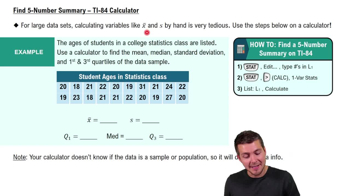Here are the essential concepts you must grasp in order to answer the question correctly.
Percentiles
A percentile is a measure used in statistics to indicate the value below which a given percentage of observations fall. For example, the 30th percentile (P30) is the value below which 30% of the data points lie. To find a specific percentile, the data must be ordered from least to greatest, and then the appropriate position can be calculated using the formula: P = (n + 1) * (percentile/100), where n is the number of data points.
Quartiles
Quartiles are specific percentiles that divide a dataset into four equal parts. The first quartile (Q1) represents the 25th percentile, the second quartile (Q2) is the median or 50th percentile, and the third quartile (Q3) is the 75th percentile. Quartiles help summarize the distribution of data and are useful for identifying outliers and understanding the spread of the dataset.
Recommended video:
Find 5-Number Summary - TI-84 Calculator
Data Ordering
Data ordering is the process of arranging data points in a specific sequence, typically from smallest to largest. This step is crucial for calculating percentiles and quartiles, as it allows for accurate identification of the position of values within the dataset. Properly ordered data ensures that statistical measures reflect the true distribution and characteristics of the data being analyzed.
Recommended video:
Visualizing Qualitative vs. Quantitative Data






